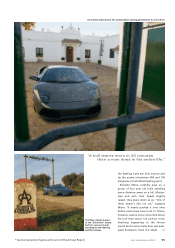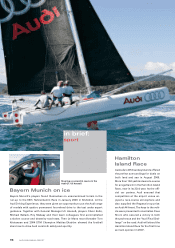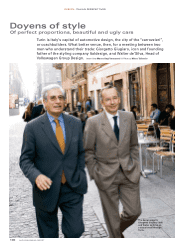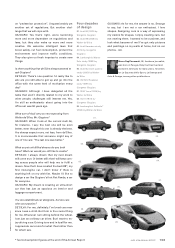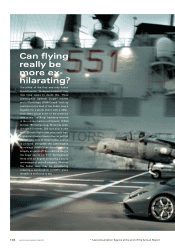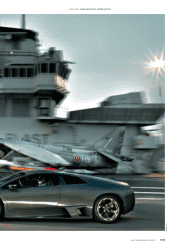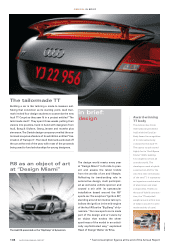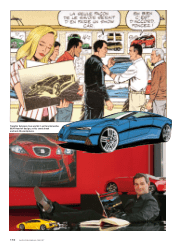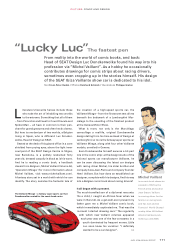Audi 2006 Annual Report Download - page 103
Download and view the complete annual report
Please find page 103 of the 2006 Audi annual report below. You can navigate through the pages in the report by either clicking on the pages listed below, or by using the keyword search tool below to find specific information within the annual report.that wanted to get right to the top, something
it has subsequently achieved. I particularly re-
member Dr. Ludwig Kraus, whom Ferdinand
Piëch had poached from Mercedes and brought
to Ingolstadt. He needed a whole day to reach
a decision on the curvature of a rear lid. It was
already clear that the Audi brand had the quest
for absolute perfection in its blood.
You are both regarded as doyens of style.
What is the significance of a car’s styling?
DE’SILVA: I would first of all emphasise how im-
portant Italian style still is for automotive design.
We are ambassadors all over the world. I live and
work in Germany and am conscious that our
creativity, simplicity and good taste are held in
high esteem. That’s very satisfying to know. And
also very important, because it means that a grand
tradition is being upheld. Italian style has made
an indelible mark on the car industry, on indus-
trial design and in the fashion world. That’s very
nice, and we hope it will remain so in the future.
GIUGIARO: That’s right, Walter, though Italian
style has also been copied by others for commer-
cial purposes. Particularly by the Japanese, who
have learned a lot from our special approach.
Italy was a poor country after the Second World
War. So we designers had to work with the few
things that we had at our disposal. Minimal use
of materials, avoidance of superfluous repeti-
tions: simple design was born out of necessity.
That’s why it is possible to state that Italian style
stems from a mentality that has also borne fruit
in other areas.
It’s now very rare to see a car that is really ugly.
Why is that?
DE’SILVA: Perfect proportions are always partic-
ularly appreciated. If everything is in the right
place in a car, the effect is balanced.
GIUGIARO: The caras a product has now become
much more mature. All vehicles are much more
progressive today, and that impacts the design.
People notice that, just like good music.
How can you tell whether a car is
stylistically successful or ugly?
GIUGIARO: To assess a car, you
have to experience it out on the
roads, alongside others. A car is
something to be experienced with
patience. At motor shows we often
see new models that we’re
Mr. de’Silva, when did you discover
Giugiaro? And you, Mr. Giugiaro,
when did you discover de’Silva?
DE’SILVA: Giugiaro was already a big name when
I started my career. He was my idol. I still remem-
ber leafing through an Italian design magazine
called “Stile Auto” that my father brought home
for me. That was in about 1972, two years before
the appearance of the Mark 1 VW Golf that
Giugiaro had designed for Volkswagen. At that
time, there were Pininfarina, Bertone and him. I
fell in love with automotive design when I read
that magazine and looked at the drawings.
GIUGIARO: Walter then joined IDEA, a new car
design studio that had been set up in Turin in the
1980s. He soon made a name for himself in our
circles. He honed his skills by switching to Alfa
Romeo and indisputably became the new star in
the firmament of automotive design. And I be-
lieve I too played a small part in Walter’s suc-
cesses. One day Ferdinand Piëch asked me what
I thought of de’Silva, whom he wanted to recruit
for SEAT within the Volkswagen Group. And I
said: that’s the best choice you could possibly
make. So I even knew about de’Silva’s new post
at SEAT before he himself did! (smiling mischie-
vously …)
That makes Giugiaro one of the patrons of your
career, Mr. de’Silva. But what does Giugiaro
mean for car design?
DE’SILVA: Giorgetto is our leading light. He was a
teacher to us young designers. Because com-
pared with designers such as Pininfarina and
Bertone, he also broke with traditions. With his
company Italdesign, he viewed the car more
clearly in the context of industrial design and did
not limit himself to purely stylistic aspects of the
body. The way he presented his work also set him
apart from the rest. He was always one step
ahead of everyone else.
Mr. Giugiaro, as well as the Mark 1 VW Golf you
designed the first Audi 80 from
1978. What do you recall of that
project?
GIUGIARO: I remember all the
things that the manufacturer want-
ed to put into that car. At that time
we regarded it all as utterly utopian.
Aluminium, windows flush with the
outer skin. Audi was already a brand
Walter de’Silva (57) is
rated as one of the
best car designers in the
world. The Italian was
Chief Designer of the
Audi brand group from
March 2002 to January
2007, and therefore
also responsible for
SEAT and Lamborghini.
Since February 2007,
de’Silva has been Head
of Volkswagen Group
Design. He began his
career in 1972 at the Fiat
Design Centre in Turin.
Giorgetto Giugiaro (69)
is an Italian industrial de-
signer of world renown.
He was a student of
Bertone and, in 1967, es-
tablished the company
Italdesign, active pre-
dominantly in the field of
automotive design and
now run by his son. >>
“Attractive
cars will al-
ways remain
attractive
and survive
short-lived
fashions.”
Walter de’Silva
101AUDI 2006 ANNUAL REPORT






